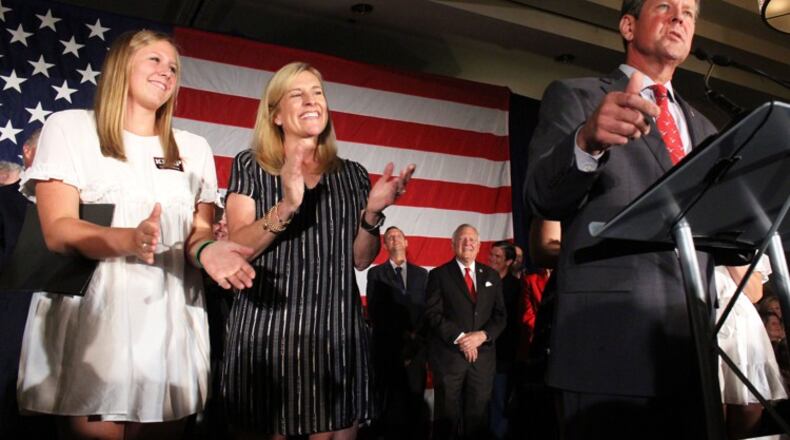Brian Kemp got a lot of new supporters with fat wallets on the July night he clinched the Republican nomination for governor.
The Capitol crowd — lobbyists, special-interest association PACs and big-money institutional donors who always give to the winners in gubernatorial races — had bet big on his GOP opponent, Lt. Gov. Casey Cagle.
But an Atlanta Journal-Constitutional analysis of recent campaign disclosures showed they switched teams in a heartbeat when Kemp crushed Cagle to win the nomination.
The AJC review found that in the three months leading up to the Sept. 30 filing deadline, more than 150 of Kemp’s contributions came from statehouse lobbyists and association political action committees, totalling about $675,000, most of it after the July 24 runoff. More than 100 of those had contributed to Cagle’s campaign, then turned to Kemp, Georgia’s secretary of state, when their candidate was vanquished.
Those figures do not include hundreds of thousands donated by well-heeled Cagle donors — such as car dealers, nursing home companies and some of Georgia’s top political givers who traditionally fill the campaign coffers of whoever wins the race.
About two-dozen lobbyists, lobby firms and statehouse association PACs also contributed to Kemp’s Democratic opponent, Stacey Abrams, a former Georgia House minority leader.
To statehouse veterans, neither that rush to back Kemp after Cagle’s loss nor the hedging of bets by some donor is a surprise.
“I think this is going to be an uncharacteristically close race,” said Tom Lewis, a longtime lobbyist for Georgia State University, who contributed $2,000 to Cagle and then, after the runoff, $1,000 to Kemp. “I think lobbyists and associations are thinking in the end, he is going to edge out the win, and they are betting on that.”
Kemp and his staffers say he won’t be influenced by such contributions.
“18 months ago, Brian Kemp announced his campaign and promised to put hardworking Georgians first — ahead of the special interests,” said Cody Hall, his campaign press secretary. “As governor, that’s exactly what he will do.”
Abrams spokeswoman Abigail Collazo said her candidate has focused on raising donations from thousands of small-money donors. More than half of the money the campaign has raised has been from outside of Georgia, with less emphasis on statehouse donors.
“From the beginning, our campaign has been grounded in the grassroots and in engaging those who have been traditionally left out and left behind,” Collazo said.
As the AJC reported earlier this month, this year's race for governor has smashed Georgia fundraising records. The Sept. 30 disclosures showed the five top Republican and two Democratic candidates in the race had raised $56.5 million, with Abrams and Kemp combining to take in about $22 million in the past three months alone.
Abrams has a national network that has helped her build a substantial war chest, but throughout the GOP nominating race, Kemp trailed Cagle in fundraising, in part because the statehouse betting money was on the lieutenant governor.
Cagle received more than 100 donations from statehouse lobbyists, and PACs for associations with lobbyists at the Capitol and families of megadonors flocked to his campaign from the start. In addition, his supporters collected millions from lobbyists and other special interests in a political fund, much of it raised just before recent legislative sessions.
As leader of the Georgia Senate, Cagle played a major role in deciding what bills received votes or died each session. He’d also been in the Georgia Senate, or headed the body, for more than two decades and had run three previous statewide campaigns, so he was a known quantity for Georgians wanting access.
Abrams and Kemp both served in the General Assembly and the Republican has been secretary of state since 2010, but neither held the kind of political power Cagle wielded.
Not only did lobbyists donate, but top firms got dozens of their clients to contribute to Cagle’s cause and held fundraisers.
By the time polls started showing Kemp building a lead in the July runoff race, some of the statehouse money started shifting to his side. On runoff night, lobbyists who had supported Cagle turned up at Kemp’s victory party.
Well before then, Kemp expected at least some lobby money to shift to his campaign if he beat Cagle. Kemp said the fact that they hadn’t backed his campaign in a big way before the runoff showed he could win without them, so he wouldn’t owe the statehouse crowd any favors if elected.
After the runoff, Cagle refunded about $540,000 in contributions meant to be used in the general election after he won the nomination.
Two industries that heavily backed Cagle, the nursing home industry and auto dealers — both traditionally big contributors to statewide candidates — each gave more than $100,000 to Kemp's campaign in recent months. Car dealers have battled in the General Assembly in recent years over how to tax the sale of used cars, while the nursing home industry has a big interest in the state budget since the government spends more than $1 billion a year on care in its facilities.
The nursing home industry has also poured big money into the state Republican Party and a PAC that is supporting Kemp.
Those weren’t the only industries that flipped. Gaming interests — who want the General Assembly to support casino gambling — have also jumped on the bandwagon. For instance, the Poarch Band of Creek Indians, which runs casinos in Alabama, contributed $17,100 to Cagle’s campaign before the runoff, and donated $6,600 to Kemp a month after the runoff.
More than 50 lobbyists and association political action committees have each given Kemp the maximum allowed for the general election: $6,600.
Among them was Lewis Massey, a former Democratic secretary of state whose firm represents businesses such as Anthem Blue Cross, Comcast, Hospital Corporation of America, Oracle, Southwest Airlines and Tesla.
Massey gave $6,600 last month. His firm had stayed out of the Republican primary race because one of his partners, John Watson, is the state GOP chairman and he didn't want to show favoritism. But his firm took part in a fundraising event for Kemp once he won the runoff.
Massey noted that Kemp was a fraternity brother when they attended the University of Georgia.
“He’s been a friend since 1982, I think, ” Massey said.
But some of Massey’s clients split their money.
The Georgia Production Partnership, a film, television, music and digital entertainment industries group, gave $6,500 to Kemp and $5,000 to Abrams. Both candidates have praised Georgia's film tax credit, which has given companies breaks to film in Georgia and is credited with helping to create a burgeoning industry in the state.
“GPP supports candidates that support the entertainment industry, and both gubernatorial candidates in this election have come out on record as supporting the Georgia entertainment incentive program,” said Peter Stathopoulos, chairman of the group’s government relations committee.
“In addition, GPP’s membership has diverse political preferences, so when both candidates support the entertainment industry, GPP will likely support both candidates to reflect that diversity in political preferences.
Few went all in for Cagle as much as GeorgiaLink, a firm with one of the longest lists of clients at the statehouse with the Atlanta Braves, Children’s Healthcare, Comcast, the small-loan association, CVS, Delta Air Lines, new-car dealers, horse racing interests, Georgia Power, UPS and dozens of others.
The firm’s partners contributed about $42,000, and their clients gave about $100,000.
A few weeks after the runoff, the lobbyists contributed $26,400 to Kemp’s campaign.
Pete Robinson, chairman of Troutman Sanders Strategies, another top lobby firm at the statehouse, put his personal money on the Republicans. He and his wife gave $34,000 to Cagle. But he also gave $1,000 to Kemp in the summer of 2017, when few in the statehouse crowd were donating to the Secretary of State. He and his family gave Kemp about $15,000 after the runoff.
His law firm’s PAC, meanwhile, gave both Kemp and Abrams $6,600 on Sept. 27. Robinson said the reason was simple.
“Our PAC is made up of all our (law firm’s) partners, and they have a lot of political persuasions and the donations fairly reflect the participants in the PAC,” he said.
William Perry, executive director of Georgia Ethics Watchdogs, said the shift in statehouse contributions from Cagle to Abrams, and especially Kemp, is to be expected.
“It’s a little bit of makeup (money), but more so it is the partisanship,” Perry said. “People want to make sure their Republican or their Democrat gets elected.”
Perry said it’s important for Georgians to know where the lobbyist and special-interest PAC money is going “because that’s usually how issues make the next legislative agenda.
“Contributions open legislative office doors more than anything else,” he said. “Candidates can talk about their top (legislative priorities), but a lot of things the lobbyists are paying for aren’t on the radar of the folks back home. They spend so much time on issues the lobbyists care about and not the issues the public cares about.”
When Brian Kemp won the GOP gubernatorial runoff in July, lobbyists and statehouse political action committees shifted their support, and money, from the man they supported, Casey Cagle, largely to him. Below is the approximate count of lobbyists and statehouse PACs who gave to Kemp in the last three months:
Statehouse lobbyists and their firms
80
Previously gave to Cagle
55
Contributions
$335,000
Statehouse association PAC contributions
74
Had previously given to Cagle
52
Contributions
$340,000
Source: Campaign finance disclosures
OUR REPORTING
It’s a busy election year, and The Atlanta Journal-Constitution is keeping the spotlight on the leading candidates for governor, Republican Brian Kemp and Democrat Stacey Abrams. AJC stories have examined Kemp’s finances and Abrams’position while in the state Legislature as a leading collector of per diem payments. Look for more stories, including a series on issues in the race, at ajc.com/politics as the state heads for the general election Nov. 6. “
About the Author
Keep Reading
The Latest
Featured




